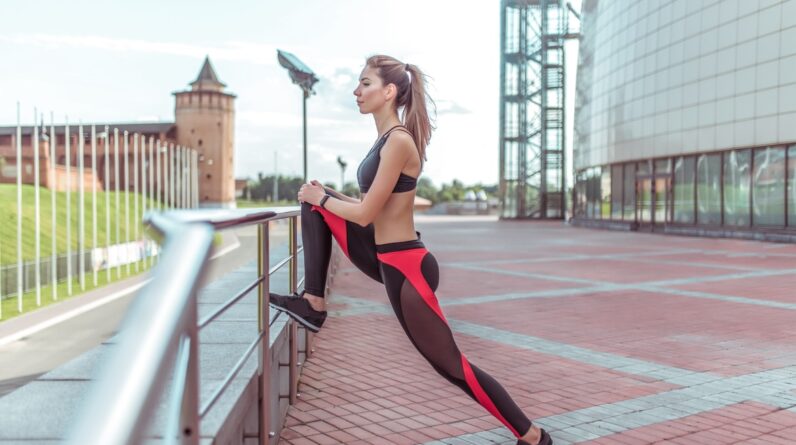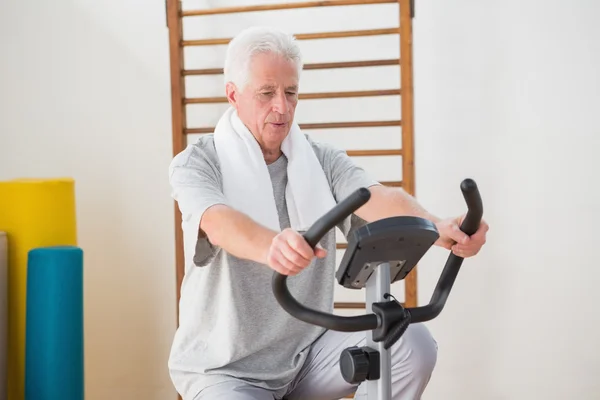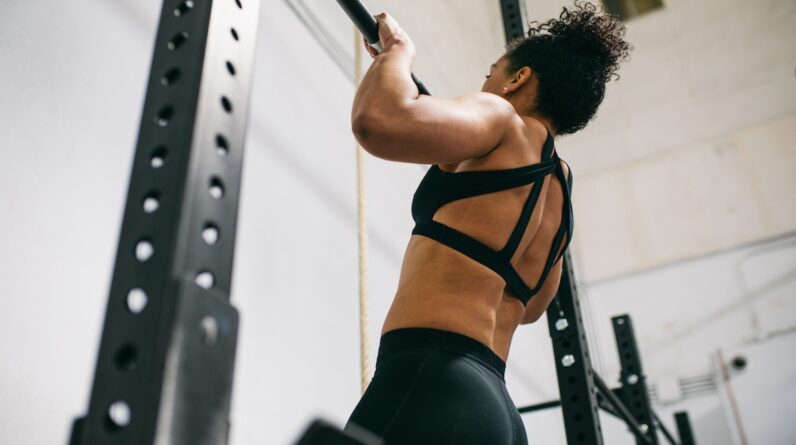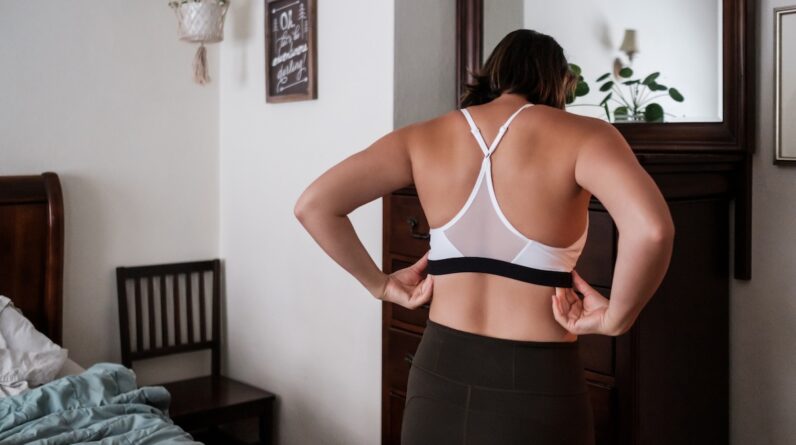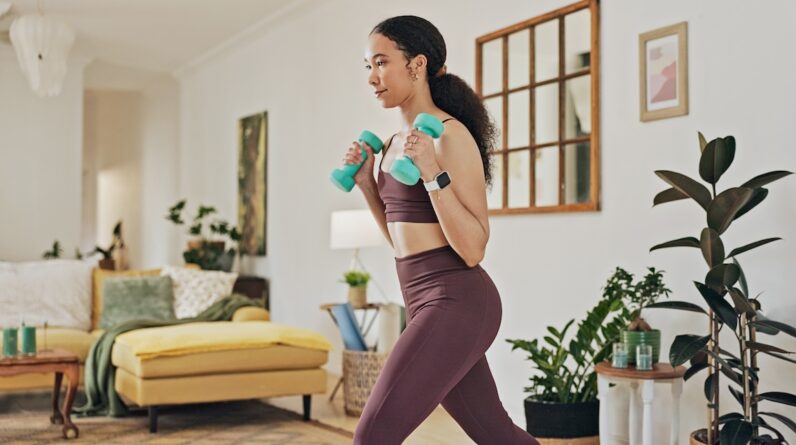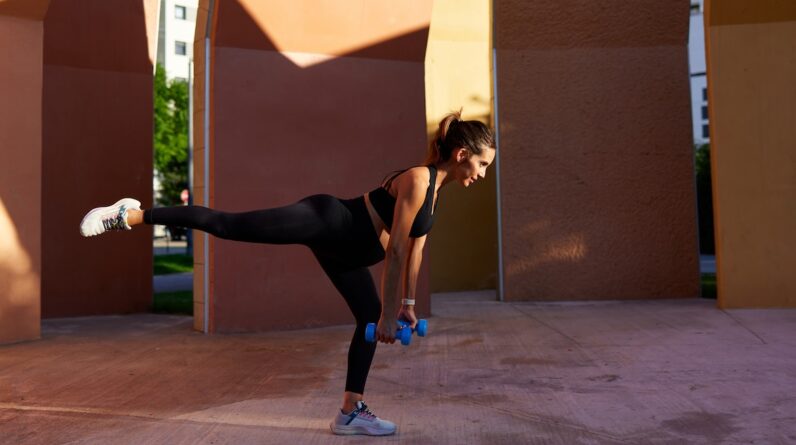
But glute loss isn’t simply an issue of your booty not filling your jeans the same. Your gluteus maximus—the largest muscle in the body—plays a big role in your everyday life. For one, it helps keep your body upright. It’s the reason you can climb a flight of stairs. All this to say, a strong backside is essential.
While this phenomenon is sometimes referred to as “mom butt,” at Well+Good we prefer to use more correct, inclusive, and body-neutral language—so we’ll be calling it what is really is, glute muscle loss.
Read on to learn why glute loss happens when you’re expecting and what you can do to bolster your butt muscles in pregnancy and postpartum.
Why “mom butt,” aka glute loss, happens in pregnancy
In pregnancy, your posture transforms dramatically. Thanks to your burgeoning baby bump, your center of gravity shifts to the front, and the rest of your body compensates for all the postural changes. All of this can lead to glute loss. Here are a few more things that can contribute.
1. You have the tendency to grip your glutes
“During pregnancy, the abs become more lengthened, and more weight is in the front of the body,” says Anna Hammond, DPT, OCS, PCES, a physical therapist at Core Exercise Solutions. But in this elongated state, your abs can’t support your body as much. To make up for this, and to counterbalance lax ligaments (they get loosey-goosey thanks to pregnancy hormones that prep you for birth), your “glutes will grip to stabilize,” she says. This means they’ll stay super tight. All. The. Time.
At first glance, you might guess this will strengthen the butt muscles, but it actually weakens them over time. Think of it like this: If you had to hold a bicep curl for nine months without relaxing the muscle, your bicep would be totally taxed.
So what does glute gripping look like? Hammond says it often appears as a “sway-back posture where the hips are shoved forward over the feet, and the rib cage is shifted back.”
“Glute gripping further compresses the back of the pelvis, shortening the posterior hip musculature,” she says.
If you’re glute gripping in the transverse plane, it’ll resemble something like “squeezing a pencil between your butt cheeks,” Hammond says. This posture can turn the feet out, lengthen adductors, and compress the posterior hip muscles even more—all contributors to “mom butt.”
When your posterior hip and glute muscles grow shorter, they can’t reach full extension. In other words, they won’t move well within the pelvis. And if these muscles don’t function optimally, they can grow weak and waste away.
On top of muscle loss, glute gripping can also be a contributing factor to pain in your hips, booty, and sacroiliac joints.
On top of muscle loss, glute gripping can also be a contributing factor to pain in your hips, booty (especially in the deep glute muscles like the piriformis and obturator internus), and sacroiliac joints (where the lower spine and pelvis meet), Hammond says. As if that’s not crappy enough, glute gripping can affect pelvic floor function too.
2. Your pelvis may tilt forward
As your belly grows bigger, it might pull your pelvis to the front. Some pregnant people develop an anterior pelvic tilt, “letting their pelvis fall forward with the weight of their abs,” Hammond says. “This can also create posterior compression, affecting how the abs and glutes can function.”
When this happens, you’re more likely to use your piriformis muscle over your gluteus medius to stabilize your pelvis, Hammond says. Problem is, this just increases the tightness in the back of your hips. An anterior pelvic tilt “can position the hip flexors into more of a shortened position, which limits hip extension range of motion,” she says.
3. Your psoas muscle might be tight
“Due to the lengthening of the abs, the body will also have the tendency to shift to using the psoas as more of a spinal stabilizer,” Hammond says. The psoas is a long muscle that starts at your lower back and passes through your pelvis to the top of your femur (thigh bone).
While your psoaas muscles’ job is to stabilize your posture, it usually works in collab with other muscles (including your abs). So when it’s forced to take the brunt of the work, things can go wrong.
Case in point: “using the psoas as a spinal stabilizer can contribute to a femur being forward in the socket,” Hammons says. Here’s why this is a problem: “Due to the roll and glide mechanics of the femur in the joint, this affects the hip being able to extend,” she says.
Put another way, when you lean on the psoas for postural support, it can become tight and stiff. And this can limit hip extension, range of motion, and access to the glutes, Hammond says, which are all things that can contribute to “mom butt.”
4. You move differently
Anyone who’s ever carried a baby has done it, especially in the third trimester: the pregnant waddle. But toddling like a penguin while pregnant can affect your glutes.
“During pregnancy, our pelvis changes position to accommodate the growth of the baby,” Hammond says. The top of the pelvis is wider and the bottom becomes narrower. “This position can also provide more stability to counter the increase in ligament laxity that occurs due to hormone shifts,” she says.
Toddling like a penguin while pregnant can affect your glutes.
The thing is, by doing so, “the body ends up sacrificing mobility for stability,” Hammond says. Instead of being able to move from one side of the pelvis to the other and between the sacrum and the ilium, “the body ends up moving as one unit,” she says. And this is why you do the pregnant waddle.
But this pelvic position (and the waddle) “puts the posterior aspect of the hip, including your glute max, into a more shortened and compressed position,” Hammond says. Again, shortened glutes don’t work very well.
This position can also make the legs rotate more externally (think: turned out feet when you waddle). This can affect other nearby muscles, such as the adductors and medial hamstrings, and limit hip internal rotation, Hammond says. All bad news for your butt muscles.
5 ways to prevent glute loss in pregnancy
Your body goes through a ton of changes during pregnancy, many you can’t control. While you may not be able to prevent glute loss, you can minimize it (and the accompanying aches and pains). Try the following things to keep your glutes strong and long during pregnancy (bonus: they’ll also help in your postpartum recovery).
Before you do any physical activity, always check in with your ob-gyn or midwife. Some pregnant people have conditions that may make certain exercises unsafe. Similarly, some movements may be too strenuous in the early postpartum period.
1. Try postural tweaks
“There is no such thing as the perfect posture,” Hammond says. The goal is just to “be better stacked.” With better alignment, your body will be more stable, and your glutes will have to do less gripping.
And it doesn’t take a whole lot of changes. You’d be surprised how small tweaks to posture can make a big difference. “Posture tips can sometimes be as simple as lifting up tall through the crown of your head as if you’re trying to listen to something behind you,” Hammond says. “This doesn’t mean thrusting your ribs up and lifting your chest.” Instead, imagine “as if someone is pulling your pony tail straight up toward the ceiling,” she says. “You should feel a slight lift of the lower abs and pelvic floor, but without a lot of active engagement.”
Other helpful posture cues:
- If your hips tend to sit far forward (i.e., they’re being pulled by your growing belly), actively remind yourself to shift them back
- Think of a giant hook lifting up the back of your bra to help drop your ribs down in the front (without gripping or shifting back)
While being mindful of your posture is a smart idea, don’t get so hung up on it that your stance becomes stuffy and stiff. “Posture should be fluid,” Hammond says. Don’t force “yourself to hold one position so much that you create tension and gripping in muscles or limit your ability to move freely,” she says.
2. Practice 360 breathing
As the name implies, 360 breathing involves using deep breaths to expand your rib cage and abdomen in every direction, i.e., 360 degrees all the way around.
OK, you’re probably wondering, what does deep breathing have to do with my glutes? “Rib cage, diaphragm, and pelvic floor mechanics all help with postural support, core control, and hip function,” Hammond says. So showing them some love through deep breathing can have a positive downstream effect below in your butt.
In fact, a little belly breathing can go a long way. “This can help with the sway-back posturing, addressing pelvic floor tightness that can affect glute function, and allow you to get a bit more support from your core,” Hammond says.
Here’s how to do it:
- Sit up tall, with your shoulders, head, and neck relaxed.
- Place one hand on your upper chest and the other just below your rib cage, so you can feel your diaphragm move as you breathe.
- Breathe in slowly through your nose. Focus on sending the breath down and back on the inhale, expanding the rib cage in all directions.
- You should feel your stomach move out against your hand (while the one on your chest should be still).
- Slowly exhale through pursed lips. Encourage the exhale to be from the bottom up and twice as long as the inhale. Feel your belly draw back in toward your spine.
Keep in mind, though, 360 breathing can be trickier with a bigger belly. For one, there’s less space in the abdominal cavity, Hammond says. Plus, your ribs widen to accommodate the growing baby bump, she says. These things can make deep breathing a bit harder (think: your lungs may not be able to fully expand when you take a big breath). Just be patient, try to relax, and do the best you can.
3. Focus on eccentric lengthening
Between glute gripping and all the other ways your body compensates for your growing belly, your hips and glutes grow shorter and tighter. To combat this, “you need to work on eccentric lengthening and internal rotation,” Hammond says. Eccentric glute lengthening will help get your femur back in the socket, she says. When your thigh bone is in its proper place, your hips will work better (they’ll be able to extend and move in their full range of motion). And your glute muscles will too.
Some of the best exercises for eccentric glute lengthening are ones you probably know: split squats and hip hinges (think: good mornings). With both movements, you want to make sure you’re using your glute maximus (versus your deep hip rotators) to help keep the femur centered in the socket, Hammond says.
Some of the best exercises are ones you probably know: split squats and hip hinges (think: good mornings).
Whether you’re split squatting or hip hinging, here’s how to achieve this: Think of pushing the ground away and rooting through the outside of the heel and base of the big toe as you come up out of each movement, Hammond says.
4. Strengthen your adductors
Your inner thighs (i.e., adductors) play a pivotal part too. “You can use adductors to support the eccentric lengthening of the glutes,” Hammond says. Strengthening the adductors can improve the position of the femur, she says. As we know, proper femur placement is key for healthy hip extension and glute function. Engaging the inner thighs during leg work can also offset the deep hip rotators when they’re tight.
A great exercise to engage the adductors is squatting with a yoga block between your knees (a rolled-up towel or pillow works too). When you squat, squeeze in on the block. It’s as simple as that. This tiny tweak will fire up those inner thigh muscles.
5. Engage your hamstrings
As your pelvis gets wider (and sometimes tips forward) in pregnancy, your hamstrings get overly lengthened. When this lengthening happens, your hammies won’t work as well and neither will your glutes, resulting in “mom butt.”
Hamstring activation can help combat this anterior pelvic tilt problem and support postural alignment, Hammond says. By doing exercises that focus on engaging the proximal hamstrings, you can “reorient the pelvis,” she says. This sets up the glute muscles for better function.
Try this simple hamstring activation exercise by Core Exercise Solutions.
A final word on exercise in pregnancy and postpartum
Even if your provider gives you the greenlight to exercise, it’s always important to pay attention to your body. Pregnancy not only affects the glutes but the pelvic floor and core as well.
So when you do any exercise during pregnancy or postpartum, you should always track the following things, Hammond says:
- Monitor for any feelings of bearing down, pressure, or leaking into your pelvic floor
- Monitor what’s happening through your midline of your abs (excessive stress or strain can increase your risk of diastasis recti, i.e., when the left and right abdominals separate)
“You’d want to modify or avoid activities that are creating pressure through your midline (contributing to a diastasis recti) or down into your pelvic floor (contributing to pelvic floor dysfunction),” Hammond says.
And if you have any pain in your sacroiliac joints or pelvis during exercise, stop doing it ASAP. “You could have a rotation in your pelvis and imbalances in your hip muscles that need to be assessed and addressed by a physical therapist,” she says.


